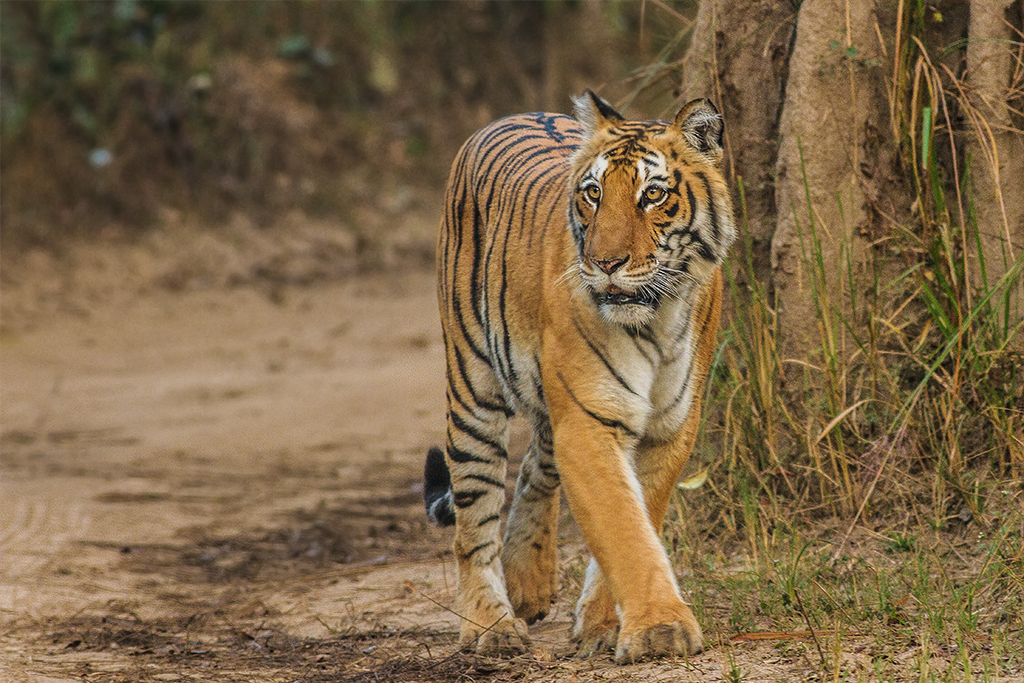was a hunter who later became a wildlife conservationist.
https://en.wikipedia.org/wiki/File:Jim_Corbett.jpg
Having hunted man-eating tigers and leopards in India, he later authored
“Man-eaters of Kumaon”
and other books in which he wrote about his hunts and experiences.
Incidentally, it may be possible to read “Man-eaters of Kumaon” for free online.
Try searching for it on the internet.
Eventually, Jim Corbett the hunter became Jim Corbett the conservationist
of wildlife and forests.
He was influential in establishing a national park in India to protect
the endangered Bengal tiger, and the park was later renamed in his honour.
Located in beautiful Nainital district of Uttarakhand, India,
Jim Corbett National Park is also a part of Project Tiger.
Tigress walking on the gypsy track in Bijrani zone.
Photo by Soumyajit Nandy.
Photo link:
Other links:
Speaking of the above area, Corbett was born in the town of Nainital in India on the 25th of July 1875. (Zodiac sign: Leo).
The side view of Gurney House where Jim Corbett used to stay (Nainital, India)
Photo by Schwiki
Photo link:
In 1947, however, he moved to Kenya in East Africa.
He went to live in the Kenyan town of Nyeri, which is near Mount Kenya
and near Treetops Hotel in Aberdare National Park.
“Treetops became famous around the world
when Princess Elizabeth, as she then was,
stayed there at the time of the death of her father,
King George VI, which occurred on the night
of 5/6 February 1952, while she was at Treetops.“
“Jim Corbett, her bodyguard at the time,
wrote the now famous lines in the visitors' log book:
For the first time in the history of the world,
a young girl climbed into a tree one day a Princess
and after having what she described as her most thrilling experience
she climbed down from the tree next day a Queen —God bless her.“
Jim Corbett continued to live in Kenya, in Nyeri,
and it is in that town that he passed away
on the 19th of April 1955, at the age of 79.
His last resting place is Nyeri.
Incidentally, Nyeri is also connected to Lord Baden-Powell
(1857-1941), founder of the Scout Movement.
"In 1939, Baden-Powell and Olave moved to a cottage he had commissioned in Nyeri, Kenya, near Mount Kenya,...
The Paxtu cottage is integrated into the Outspan Hotel buildings and serves as a small Scouting museum.
Baden-Powell died on 8 January 1941 and is buried at St. Peter's Cemetery in Nyeri."
As mentioned earlier in this post, Jim Corbett moved to Nyeri, Kenya, in 1947 -- a few years after Baden-Powell had passed away.
And, as per a Wikipedia article on Nyeri,
(see the last paragraph of the “Tourism” “In Town” part),
Jim Corbett "also spent his final years in Paxtu, the B-P's cottage."
Further,
"In 1994 and 2002, the long-neglected graves of Corbett and his sister (both in Kenya) were repaired and restored by Jerry A. Jaleel, founder and director of the Jim Corbett Foundation."
In addition, during his time in Kenya, I wonder whether Jim Corbett,
author of “Man-eaters of Kumaon”, went to visit a certain area of Tsavo
-- that particular part of the Kenyan wilderness
which became well-known in 1898...
because of two man-eating lions
-- the man-eaters of Tsavo...


